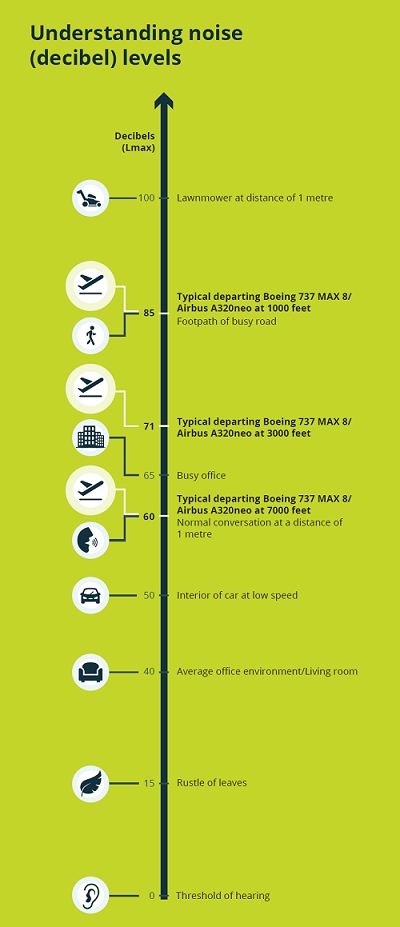Noise Monitoring

Noise Monitors or Noise Monitoring Terminals (NMT) are put in place to record and monitor aircraft noise in locations around Dublin Airport.
When considered in conjunction with the annually calculated and published airport noise contours, the system allows us to track noise over time and evaluate trends.
Dublin Airport has a combination of both fixed and mobile noise monitors. As of early 2024, Dublin Airport has 19 fixed monitors as well as three mobile noise monitors which generally spend about six months at a set location as agreed with representatives from local community groups.
Almost live noise readings measured by our noise monitors can be found on WebTrak. By visiting this site, you can track aircraft arriving and departing from Dublin Airport and view the noise readings measured from the noise monitors. In addition, noise contours can also be found on WebTrak.
Noise monitoring reports are published quarterly. These reports detail the monitored locations, measurement results and data analysis. The report aims to provide a comprehensive understanding of noise levels and guide regarding noise mitigation and management strategies. To view these reports, click here.
Noise Monitoring FAQ's
Noise Monitors measure the noise level received at its microphone. A Noise Monitor is “blind” in that it simply sends a stream of noise data to the Airport Noise Monitoring System (ANOMS). The ANOMS system monitors the noise data at each noise monitor. When the noise levels rise above a pre-set threshold level specific to the location, remains above that threshold for a specific period (e.g. a few seconds to a minute), and then drops below the threshold, ANOMS stores this data as a ‘Noise Event’. ANOMS accesses flight radar data and if the timing of a noise event and location of the Noise Monitor matches a flight in the area, the event becomes an ‘Aircraft Noise Event’. Noise Events that do not correlate to an Aircraft Noise Event are deemed to be non-aircraft noise and can include vehicles, sirens, animals or wind in trees. These events are referred to as ‘Community Noise Events’.
Noise event data (including aircraft and non-aircraft or community noise) is included in our published Quarterly Reports as required by Condition 10 of the grant of planning for North Runway.
This data helps Dublin Airport to monitor aircraft noise around the airport and in communities in line with our responsibilities under the Dublin Airport Noise Act (2019) and as required by the Aircraft Noise Competent Authority (ANCA). This data is also used for noise contour modelling and noise contours are published on an annual basis.
Currently, there are 19 fixed noise monitors in place across Dublin, Meath and Wicklow with an additional three mobile noise monitors in situ in their nominated locations. Dublin Airport is further expanding its noise monitoring network with a further six fixed noise monitors planned for installation during 2024.
To view the noise monitors’ locations and their near live information please click here.
Most noise monitors are located within 10 kilometres of Dublin Airport with six located further afield in surrounding areas. 19 fixed noise monitors are in place across Dublin, Meath and Wicklow with an additional three mobile noise monitors in situ in their nominated locations.
The fixed noise monitor locations are Ardgillan, Ashbourne, Balcultry, Bay Lane, Bishopswood, Donabate, Dunboyne, Feltrim, Kilcoscan National School, Malahide, New Park, Portmarnock, Ratoath, Roundwood, St. Davids, St. Doolaghs, St. Margarets, Summerhill and Swords.
Dublin Airport is further expanding its noise monitoring network with a further six fixed noise monitors planned for installation during 2024. The intended locations are Portmarnock, Ballyboughal, Lucan, Ongar, Clondalkin and Bray.
The three mobile noise monitor locations are nominated and agreed with representatives from local community groups.
The location of all noise monitors can be viewed on WebTrak, our web-based service that monitors and provides information on flights and noise levels related to aircraft using Dublin Airport.
To view the noise monitor locations and their near live information please click here.
Noise monitoring sites are usually selected to measure aircraft noise in communities near the airport and at locations underneath frequently used flight paths.
In some cases, Dublin Airport has been directed by the Aircraft Noise Competent Authority to install monitors quite far from the airport. Further from the airport, overflights are fewer in number and aircraft are at higher altitudes therefore generating lower aircraft noise levels. However, these further out noise monitors can be useful for providing confidence in the calculated airport noise contours both in high noise and low noise areas.
In some cases, noise monitors can be located to target specific data such as the noise levels of individual flights.
When deciding on a mobile noise monitoring location, our main aim is to achieve an equitable geographical spread around the airport so that as many communities as possible are included in our programme.
